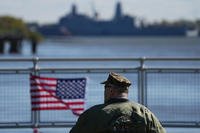The head of U.S. Air Force Special Operations Command has renewed his commitment to fielding an AC-130 “mini arsenal plane” equipped with a high-energy laser (HEL) by 2020, according to Aviation Week & Space Technology.
Lt. Gen. Bradley Heithold says one of his organization’s dozen AC-130W gunships at Cannon AFB, New Mexico, has been designated as the first host aircraft, and that there are ready crews and funded flight hours available for industry partners to leverage.
The aircraft does not carry the 105mm cannon installed on other operational “Stinger II” gunships—affording more size, weight and power—but any proposed laser unit will occupy the 30mm gun position forward of the wing, where airflow is less disturbed.
“We already have people out there with tape measures,” Heithold said at the Center for Strategic and Budgetary Assessments’ directed-energy summit in Washington on June 23.
Heithold wants an offensive laser weapon initially, which a recent study by the Naval Surface Warfare Center-Dahlgren says “provides lower programmatic and technical risk” than a defensive capability for knocking out surface-fired or air-to-air missile threats.
The air commandos leader says defensive laser capability can come later. For now, he is pushing a 60-kW or 120-kW high-powered laser, depending on technology readiness, for disabling stationary vehicles, aircraft and fixed communications nodes such as cellphone towers.
AFSOC already has published a secret-level concept of operations document addressing the way a laser-equipped gunship would be used in battle, and other organizations within the Defense Department are defining tactics, techniques and procedures for laser weapons.
“These things will be worked out,” Heithold says. “There will be strict rules of engagement for the use of lasers, just like there is for a tactical nuke.”
AFSOC is buying 37 -- seven have been built AC-130J Ghostriders so far, and two have been delivered to operational units. Ghostrider’s precision strike package includes 30mm and 105mm cannons as well as tube-launched and wing-mounted missiles and glide bombs.
Heithold revealed his ambitious “Moon shot” laser gunship initiative at the 2015 Air Warfare Symposium in Orlando, Florida, and there have been multiple feasibility studies conducted since then.
As the Pentagon formulates its fiscal 2018 budget blueprint, AFSOC has recommended that $4-5 million per year be included in U.S. Special Operations Command’s five-year spending plan to “keep this effort alive,” although Heithold admits much more money is needed to reach the “end zone.”
Air Force Materiel Command’s chief, Gen. Ellen Pawlikowski, speaking at the June 23 summit, cautioned directed-energy advocates within industry and the government about over-promising and under-delivering, as happened with the multibillion-dollar Boeing YAL-1 Airborne Laser experiment. She is cautiously supportive of Heithold’s gunship plan, but warned against trying to rush development of such a complex technology.
CSBA Senior Fellow Mark Gunzinger believes the Air Force can achieve a flying prototype by 2020 with the right level of funding. He also believes the AC-130 is the right platform, having already demonstrated a chemical laser weapon through the Advanced Tactical Laser program, and there is a clear need by operators for both offensive and defensive directed-energy capabilities.
“There has been a laser on a gunship already, and it worked, but it ate up most of the gunship,” Gunzinger says. “Getting from a laser that works in the lab to fully integrating it into a package ready to stuff into an aircraft, there is a lot more engineering left to do. Can they do it by the end of the decade? Sure. But you want to do it right and take the time.”









